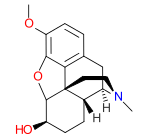Dihydroisocodeine
Dihydroisocodeine is an opioid.[1] The National Research Council of the United States reported in 1941 that isocodeine is one of four isomers of codeine known at the time (heterocodeine can be considered a fifth) and DHIC, then in use in Europe as a pharmaceutical, was four times stronger than dihydrocodeine as isocodeine is four times stronger than codeine. The other isomers of codeine are allocodeine and pseudocodeine and they are active drugs as is heterocodeine, which is estimated to be up to 108 times as potent as codeine. [2]
 | |
| Names | |
|---|---|
| IUPAC name
(4R,4aR,7R,7aR,12bS)-9-Methoxy-3-methyl-2,4,4a,5,6,7,7a,13-octahydro-1H-4,12-methanobenzofuro[3,2-e]isoquinoline-7-ol | |
| Other names
DHIC | |
| Identifiers | |
3D model (JSmol) |
|
| ChemSpider | |
PubChem CID |
|
| UNII | |
CompTox Dashboard (EPA) |
|
| |
| |
| Properties | |
| C18H23NO3 | |
| Molar mass | 301.386 g·mol−1 |
Except where otherwise noted, data are given for materials in their standard state (at 25 °C [77 °F], 100 kPa). | |
| Infobox references | |
References
- Parker, KA; Fokas, D (2006). "Enantioselective synthesis of (−)-dihydrocodeinone: A short formal synthesis of (−)-morphine". The Journal of Organic Chemistry. 71 (2): 449–55. doi:10.1021/jo0513008. PMID 16408951.
- Report of the Committee On Drug Addiction 1929-1941 With Monographs; National Research Council (US) New York, Washington, Philadelphia 1941, 1116 pages
This article is issued from Wikipedia. The text is licensed under Creative Commons - Attribution - Sharealike. Additional terms may apply for the media files.